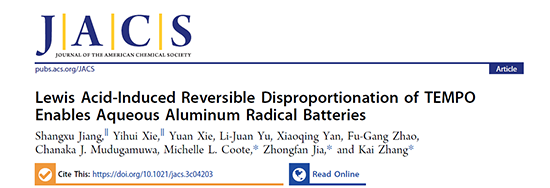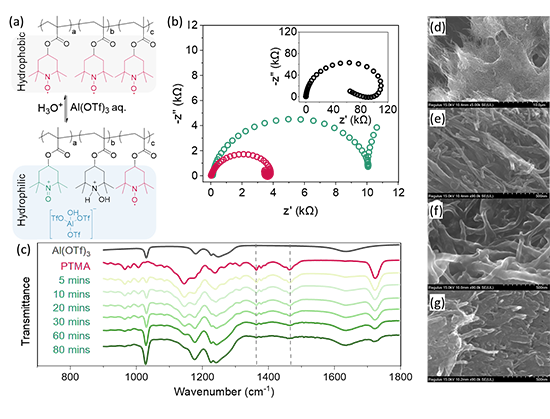铝电池具有理论容量高,安全性好、成本低等优点,是新一代储能技术的代表。设计和开发高比能、绿色可持续正极电极材料是构建高性能铝离子电池的关键。氮氧自由基(TEMPO)聚合物作为典型有机正极材料已被广泛应用于锂离子电池、钠离子电池、锌离子电池等电池体系,并表现出高电压、高功率、绿色可再生特性。然而,由于多数氮氧自由基在路易斯酸有机电解液中电化学氧化还原不可逆,使其无法应用于铝离子电池正极材料。例如,在酸性Al(OTf)3乙腈电解液中,TEMPO歧化成TEMPO+与 TEMPO-,而后者与Al(OTf)3配位形成稳定的[Al(OTf)3TEMPO]-络合物,其较高的氧化电位导致TEMPO电化学氧化还原不可逆而无法应用于铝电正极。


解决TEMPO电极材料在Al(OTf)3路易斯酸体系中的电化学氧化还原可逆性的关键问题后,他们制备经典TEMPO官能化聚合物PTMA(图2a)正极材料并尝试构建水系铝离子电池。电池测试表明:虽然疏水性聚酯结构PTMA在水系电解液中无法溶胀,表现出极高的电子转移阻抗(~100 kΩ),严重阻碍了离子传输与电池充放电(图2b),但在Al(OTf)3诱导歧化反应后生成TEMPO+与 [Al(OTf)3TEMPO]- 离子,赋予PTMA一定的亲水性,显著降低电子转移阻抗(~10 kΩ),实现了PTMA正极的正常充放电(图2b & c)。SEM表征佐证了相关电化学结果:未经充放电时PTMA聚合物在导电碳纳米管表面呈现疏水团聚状,经歧化活化与充放电后PTMA在水系电解液中溶胀并均匀包覆于导电碳纳米管表面(图2 d-g),有效促进电解质传输。综上,PTMA歧化活化过程对提高电解质盐在疏水PTMA电极中的离子传输,实现PTMA铝离子电池充放电至关重要。

该电池提供大于1.25 V的输出平台电压和接近理论的110 mAh g-1比容量(图3a & b)。此外,PTMA铝离子电池展现出优异的倍率性能,在8 C的高倍率条件下仍保有理论容量的81%,且在超过800次的充放电循环中每圈容量损失仅为0.028% (图3c)。此外,PTMA铝离子电池也表现出优异的阻燃性能和空气稳定性。该研究为开发铝基高能量、功率密度动力电池及高安全性大型储能电站提供新方案。

上述成果发表于Journal of the American Chemical Society期刊;硕士研究生蒋尚旭和谢逸辉为共同第一作者,张凯博士和澳大利亚弗林德斯大学贾中凡教授、Michelle L. Coote教授为共同通讯作者,浙江理工大学为第一完成单位。
论文链接:https://doi.org/10.1021/jacs.3c04203
作者简介
张凯
2018年于澳大利亚昆士兰大学获理学博士学位;2018-2020年在美国约翰霍普金斯大学开展博士后研究。2020年加入浙江理工大学化学与化工学院,任特聘副教授。主要研究领域为能源和高分子化学,研究兴趣包括铝离子电池、聚合物基柔性电池、有机水系液流电池等的机理研究和结构设计。以通讯作者/第一作者身份在J. Am. Chem. Soc., ACS Energy Lett., Energy Storage Mater., J. Mater. Chem. A, Chem. Eng. J.等学术刊物上发表论文十余篇,受到了国内外学术界的广泛关注。
Zhongfan Jia(贾中凡)
Zhongfan Jia is an Associate Professor of Chemistry at Flinders University, Australia. He graduated from Fudan University with a PhD in Polymer Chemistry and Physics in 2007, followed by a postdoctoral position in the Centre for Advanced Macromolecular Design (CAMD) at the University of New South Wales. From 2009 to 2020, he was a senior research fellow at the Australian Institute for Bioengineering and Nanotechnology (AIBN), the University of Queensland. He is a recipient of the Australian Research Council Future Fellow and Advanced Queensland Industry Fellow. In 2019, he was appointed as a Lecturer in Chemistry at the University of New England. He joined Flinders University as a Senior Lecturer in 2020 and was promoted to Associate Professor in 2022. His research interests include polymer chemistry, organic electrochemistry, biomaterial, catalysis, and energy storage.
Michelle L. Coote
Professor Michelle Coote is a Georgina Sweet ARC Laureate Fellow and is also an Executive Editor of the Journal of the American Chemical Society. She graduated with a PhD from the University of New South Wales. She established her own research group at the ANU in 2004, where she was promoted to Professor in 2011. She moved to Flinders University as a Matthew Flinders Professor in Chemistry in 2022. She is a member of the new ARC Centre of Excellence for Quantum Biotechnology. Professor Coote is an elected fellow of the Australian Academy of Science (FAA), the Royal Australian Chemical Institute (FRACI) and the Royal Society of Chemistry (FRSC). She has received many awards including the recent HG Smith Medal (2016), the RSC Australasian Lectureship (2020) and Leighton Medal (2021) Her current research spans theoretical and experimental chemistry, in areas as diverse as polymer chemistry, organic synthesis, physical chemistry and organometallic catalysis.
- 安徽大学张朝峰教授团队 AM:用于-20至45℃宽温域的高性能水系铝离子电池的电聚合双极型聚(2,3-二氨基吩嗪)正极 2024-03-06
- 浙大高超教授课题组:低成本的铝离子电池体系 2019-03-28
